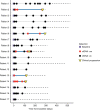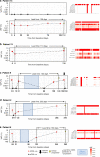Liquid BIOpsy for MiNimal RESidual DiSease Detection in Head and Neck Squamous Cell Carcinoma (LIONESS)-a personalised circulating tumour DNA analysis in head and neck squamous cell carcinoma
- PMID: 35132238
- PMCID: PMC9023460
- DOI: 10.1038/s41416-022-01716-7
Liquid BIOpsy for MiNimal RESidual DiSease Detection in Head and Neck Squamous Cell Carcinoma (LIONESS)-a personalised circulating tumour DNA analysis in head and neck squamous cell carcinoma
Abstract
Background: Head and neck squamous cell carcinoma (HNSCC) remain a substantial burden to global health. Cell-free circulating tumour DNA (ctDNA) is an emerging biomarker but has not been studied sufficiently in HNSCC.
Methods: We conducted a single-centre prospective cohort study to investigate ctDNA in patients with p16-negative HNSCC who received curative-intent primary surgical treatment. Whole-exome sequencing was performed on formalin-fixed paraffin-embedded (FFPE) tumour tissue. We utilised RaDaRTM, a highly sensitive personalised assay using deep sequencing for tumour-specific variants, to analyse serial pre- and post-operative plasma samples for evidence of minimal residual disease and recurrence.
Results: In 17 patients analysed, personalised panels were designed to detect 34 to 52 somatic variants. Data show ctDNA detection in baseline samples taken prior to surgery in 17 of 17 patients. In post-surgery samples, ctDNA could be detected at levels as low as 0.0006% variant allele frequency. In all cases with clinical recurrence to date, ctDNA was detected prior to progression, with lead times ranging from 108 to 253 days.
Conclusions: This study illustrates the potential of ctDNA as a biomarker for detecting minimal residual disease and recurrence in HNSCC and demonstrates the feasibility of personalised ctDNA assays for the detection of disease prior to clinical recurrence.
© 2022. The Author(s).
Conflict of interest statement
SF, PB, CR, MC, OG and CW declare no competing interests. KH, SH, CP, KM, PE, TF and GM are employees and shareholders of Inivata Ltd (Cambridge, UK).
Figures




Similar articles
-
Deciphering molecular relapse and intra-tumor heterogeneity in non-metastatic resectable head and neck squamous cell carcinoma using circulating tumor DNA.Oral Oncol. 2025 Jan;160:107111. doi: 10.1016/j.oraloncology.2024.107111. Epub 2024 Nov 29. Oral Oncol. 2025. PMID: 39612700
-
Tumor-agnostic plasma assay for circulating tumor DNA detects minimal residual disease and predicts outcome in locally advanced squamous cell carcinoma of the head and neck.Ann Oncol. 2023 Dec;34(12):1175-1186. doi: 10.1016/j.annonc.2023.09.3102. Epub 2023 Oct 23. Ann Oncol. 2023. PMID: 37879442
-
Next-generation sequencing (NGS) profiling of matched tumor and circulating tumor DNA (ctDNA) in head and neck squamous cell carcinoma (HNSCC).Oral Oncol. 2023 Apr;139:106358. doi: 10.1016/j.oraloncology.2023.106358. Epub 2023 Mar 3. Oral Oncol. 2023. PMID: 36871349
-
Circulating tumour DNA alterations: emerging biomarker in head and neck squamous cell carcinoma.J Biomed Sci. 2023 Aug 9;30(1):65. doi: 10.1186/s12929-023-00953-z. J Biomed Sci. 2023. PMID: 37559138 Free PMC article. Review.
-
The effect of circulating tumor DNA on the prognosis of patients with head and neck squamous cell carcinoma: a systematic review and meta-analysis.BMC Cancer. 2024 Nov 21;24(1):1434. doi: 10.1186/s12885-024-13116-6. BMC Cancer. 2024. PMID: 39574043 Free PMC article.
Cited by
-
Using cfDNA and ctDNA as Oncologic Markers: A Path to Clinical Validation.Int J Mol Sci. 2023 Aug 25;24(17):13219. doi: 10.3390/ijms241713219. Int J Mol Sci. 2023. PMID: 37686024 Free PMC article. Review.
-
Using Liquid Biopsy to Predict Relapse After Radiotherapy in Squamous Cell Head-Neck and Esophageal Cancer.Cancer Diagn Progn. 2023 Jul 3;3(4):403-410. doi: 10.21873/cdp.10232. eCollection 2023 Jul-Aug. Cancer Diagn Progn. 2023. PMID: 37405217 Free PMC article. Review.
-
Adjuvant nivolumab, capecitabine or the combination in patients with residual triple-negative breast cancer: the OXEL randomized phase II study.Nat Commun. 2024 Mar 27;15(1):2691. doi: 10.1038/s41467-024-46961-x. Nat Commun. 2024. PMID: 38538574 Free PMC article. Clinical Trial.
-
Circulating Tumor DNA and Late Recurrence in High-Risk Hormone Receptor-Positive, Human Epidermal Growth Factor Receptor 2-Negative Breast Cancer.J Clin Oncol. 2022 Aug 1;40(22):2408-2419. doi: 10.1200/JCO.22.00908. Epub 2022 Jun 4. J Clin Oncol. 2022. PMID: 35658506 Free PMC article.
-
[Current trends in liquid biopsy and diagnostics-contributions from ASCO and ESMO 2022].HNO. 2023 Jul;71(7):425-430. doi: 10.1007/s00106-023-01303-z. Epub 2023 May 19. HNO. 2023. PMID: 37208494 Free PMC article. Review. German.
References
-
- Cohen N, Fedewa S, Chen AY. Epidemiology and demographics of the head and neck cancer population. Oral Maxillofacial Surg Clin North Am. 2018;30:381–95. - PubMed
-
- Machiels J-P, Leemans CR, Golusinski W, Grau C, Licitra L, Gregoire V, et al. Squamous cell carcinoma of the oral cavity, larynx, oropharynx and hypopharynx: EHNS–ESMO–ESTRO clinical practice guidelines for diagnosis, treatment and follow-up. Ann Oncol. 2020;31:1462–75.. doi: 10.1016/j.annonc.2020.07.011. - DOI - PubMed
Publication types
MeSH terms
Substances
LinkOut - more resources
Full Text Sources
Other Literature Sources
Medical

